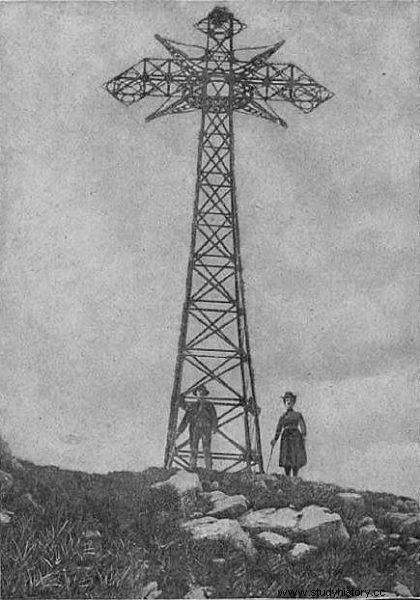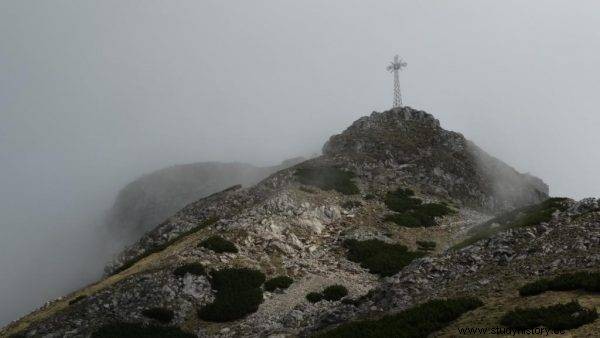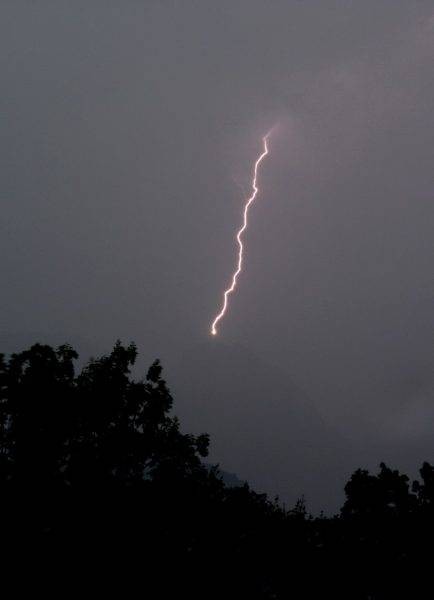The cross has been standing on Wielki Giewont for over 120 years. At that time, it became a destination for tourists, pilgrims and the site of several tragedies. Who put it there and why?
It was August 19, 1901. Almost 300 people gathered around the top of Wielki Giewont, most of them dressed in traditional highlander costumes. Father Władysław Bandurski from Krakow - in the future the chaplain of the Polish legions - also arrived, who was to sacrifice a 15-meter high metal cross. One of the symbols of Zakopane and the Tatra Mountains. How and why did the highlanders install it?
Italian design
1900 was the jubilee anniversary of the birth of Jesus Christ. In order to celebrate it, inspired by similar initiatives undertaken in the Italian Apes, Zakopane parish priest Kazimierz Kaszelewski, during his Sunday sermon, told the faithful about his idea, and they started collecting money . Some sources also say that the inhabitants of Zakopane themselves made a similar request to the clergyman. Whoever came up with this idea must have known that it would not be easy to make it happen.
"It was quite an undertaking to carry heavy bars of metal to the rocky battlements of Gewont, which would bind the cross - and fix them there, above the clouds, at an altitude of 1900 meters, on the edge a dizzying gulf . " - wrote the editor of "Głos Narodu" in August 1901.

The cross in 1901
Why the decision that the cross will stand in this place? As Walery Eljasz-Radzikowski wrote in 1880:"with you can see almost every hut of Giewont, so he rightly deserves the title of the Zakopane king ". The outlines of the mountain were also included in the seal of the Zakopane Commune from 1875. The summit also inspired writers and painters. He was, is and probably will be one of the symbols of the city.
Team hard work
The works started in the fall of 1900. First, the parish priest, a dozen or so highlanders and the climate commissioner Piątkiewicz went on a trip to Wielki Giewont. Before the group reached the place, they stopped at the last hut under the summit, from where they took two long poles. Then, at the top, the men made a cross from these wooden elements, placed it in a sixty-centimeter hole and covered it with stones . The construction was to be 10.5 meters high. After returning, all participants of the escapade were happy to say that the trial cross is visible to the naked eye from Zakopane. Father Kaszlewski only noticed that it could be a bit bigger and he turned to the contractor - Józef Gorecki's Artistic and Locksmith Plant with such a request.
When, in the late spring of 1901, a seventeen-and-a-half-meter metal cross was being built in the Krakow factory, Jakub Gąsienica Wawrytko - a well-known stonemason and friend of Stefan Żeromski - together with his helpers cut a hole almost two meters deep in the rock . But not this, after all, the difficult task was the hardest. The most difficult thing was to transport 400 elements to the top.

In 1901, mounting the cross on the top was an extremely difficult task
On June 16, 1901, a train with the ordered goods stopped at the railway station in Zakopane. Two weeks later, the parish priest gathered around 250 people (although some sources even say that the number is twice as high), who packed the broken cross into 18 horse-drawn carts and set off for the region of Kuźnice, and from there to Wielki Giewont. Father Kaszlewski later reported in the press:
- After Mass. we set off for Kuźnice, having split the iron into individual carts, which also took it to wherever it was possible, ie to the so-called “Piekiełek”. Here the division took place. Everyone had more to carry, that apart from iron they had to carry 400 kg. cement and twenty-odd watering cans . About ’ At 11 o'clock we were all happily at the top and distributed the burden. 10 cubic meters containing a pit in the rock had previously been carved, which cost two highlanders 7 days of work. After a respite at the top, everyone parted - only the owner of the factory, Mr. Górecki remained with his fitter, me and 6 highlanders to fix the bottom of the cross in the rock. When we managed to do it, despite the rain, and when we covered the pit with stones and flooded the corners with cement, we left a fitter upstairs, who with 2 highlanders assembled the rest of the cross, which cost every 6 days.
On July 8, 1901, at the top of Wielki Giewont, a cross stood 15 meters high and 5.5 meters wide. The cost of making it, carving a pit in the rock and assembling it was 735 Rhenish zlotys. At the crossing of the arms of the cross there is an inscription: Jesu Christo Deo, restitutæ per ipsum salutis MCM (Latin for Jesus Christ, God, on the 1900th anniversary of His restoration of salvation).
Since then, Wielki Giewont has become a place not only for tourist trips, but also for pilgrimages.
A place of pilgrimage and tragedy
The vicinity of the metal cross is extremely dangerous during a storm. In its over 120-year history, there have been paralysis. Many of them were fatal. In August 1937, a series of violent storms passed over Central Europe. Atmospheric discharges wreaked unprecedented havoc. 17 houses and 85 farm buildings burned down in the village of Stary Brus. In the vicinity of Białystok, lightning killed a woman. A real tragedy also took place in the Tatra Mountains, near the described cross.

Lightning hitting the cross on Wielki Giewont
Around 12:00 on August 15, 1937, from the Czerwona Wierchy, very unexpectedly dark clouds came, brightened every now and then with lightning . One of them hit a cross under which 12 people stood. Three people died on the spot. It turned out that they weren't just tourists.
" The news of the death of three people by lightning at noon on 15 May spread throughout Poland with painful echoes. on the top of Giewont, under the cross. Only one of these people was a tourist. Two other victims of lightning were Jan Mróz, son of a famous porter from Poronin, also a bagger, and an 18-year-old boy, a cookie seller, Kazimierz Bania. So, the last two people were brought to this beautiful peak, enchantingly towering over Zakopane, not the charm of a Tatra trip, not the desire to be saturated with the beauty of the mountains in the midday sun - but the daily desire to earn money. (...) This sad way we learn that on the top of Giewont there is a kind of small-town fair . " - reported Stach from Willow in the Illustrated Daily Kuryer.
The most tragic accident took place relatively recently, on August 22, 2019. On that day, as a result of a great storm over the Tatra Mountains, a total of 5 people were killed by lightning and 157 were injured. Most of the electrocution took place near the cross on Wielki Giewont.
Bibliography:
- Illustrated Daily Kuryer. 1937, No. 229 and 230 (August 19 and 20)
- "Głos Narodu" Illustrated:a free supplement to "Głos Narodu" from September 21, 1901, [No. 1], pp. 8-10.
- https://www.tpn.pl/files/news/editor/files/Foldery/krzyz_na_giewoncie.pdf (access:29.10.2021)
- https://www.zakopane.pl/strefa-turystyczna/cawodnik-zakopianski/historia-jakiej-nie-znacie/historia-krzyza-na-giewoncie (accessed:October 29, 2021)
